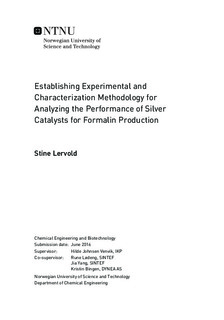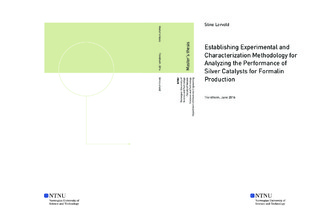| dc.description.abstract | Formaldehyde is an essential component of wood adhesives, which can be used for a wide range of applications, and is an important intermediate in the production of several fine chemicals. Industrially, production of formaldehyde from methanol is based on two main processes, where Dynea AS has identified oxidation over a silver-based catalyst in excess methanol as the favored alternative for improvements. The thesis aims at establishing a suitable characterization procedure and experimental setup methodology for silver catalysts. Results from fresh and plant-exposed catalyst were analyzed and compared in the characterization analyses.
A wide range of characterization tools were evaluated, such as scanning electron microscopy (SEM-EDX), X-ray diffraction (XRD), X-ray fluorescence spectroscopy (XRF), temperature programmed techniques (TPX), chemisorption and nitrogen adsorption. Nitrogen adsorption was unsuccessful in calculating a surface area for the silver catalyst, due to low surface area. The low surface area influenced chemisorption, and the analysis resulted in low dispersion and metal surface area. XRD showed that the catalyst contained cubic (FCC) silver, with a change in lattice constant for the exposed catalyst. The crystallite size was calculated in Topas, resulting in a decrease of crystallite size for exposed samples. XRF and EDX confirmed the relatively purity of the silver, with small traces of contaminations such as carbon formation. Redox properties of silver oxide were investigated in TGA, showing a thermodynamically favorable reduction in air/inert atmosphere at high temperature. Temperatures favoring silver oxidation based on thermodynamics were controlled by slow kinetics. SEM micrographs attained for both fresh and exposed samples showed structural and morphological changes.
The overall aim of the research is to relate catalyst activity with advanced characterization results. However, first making a reliable and practical experimental setup for formaldehyde synthesis experiments is a challenging task, due to the fast, exothermic reactions involved and the challenges associated with maintaining product stability. The focus was therefore initially towards establishing the methodology with respect to catalyst configuration, temperature control and product analysis. Thereafter, initial experiments varying the temperature, total flow and feed composition were carried out in order to identify variables critical to formaldehyde selectivity. Results from the first reaction experiments confirmed the significance of temperature and flow for both selectivity and conversion. The temperature gradient measured for the first analyses indicated that an improved furnace design would have positive influence. The results also showed that methanol conversion is highly dependent on oxygen concentration in the feed. Decreasing the void volume with silicon carbide significantly improved formaldehyde selectivity to obtain at most 82% at high conversion (90%). A reference analysis with an empty reactor was performed to establish the role of gas phase reactions, to find negligible methanol conversion below 600 ᵒC. | |

